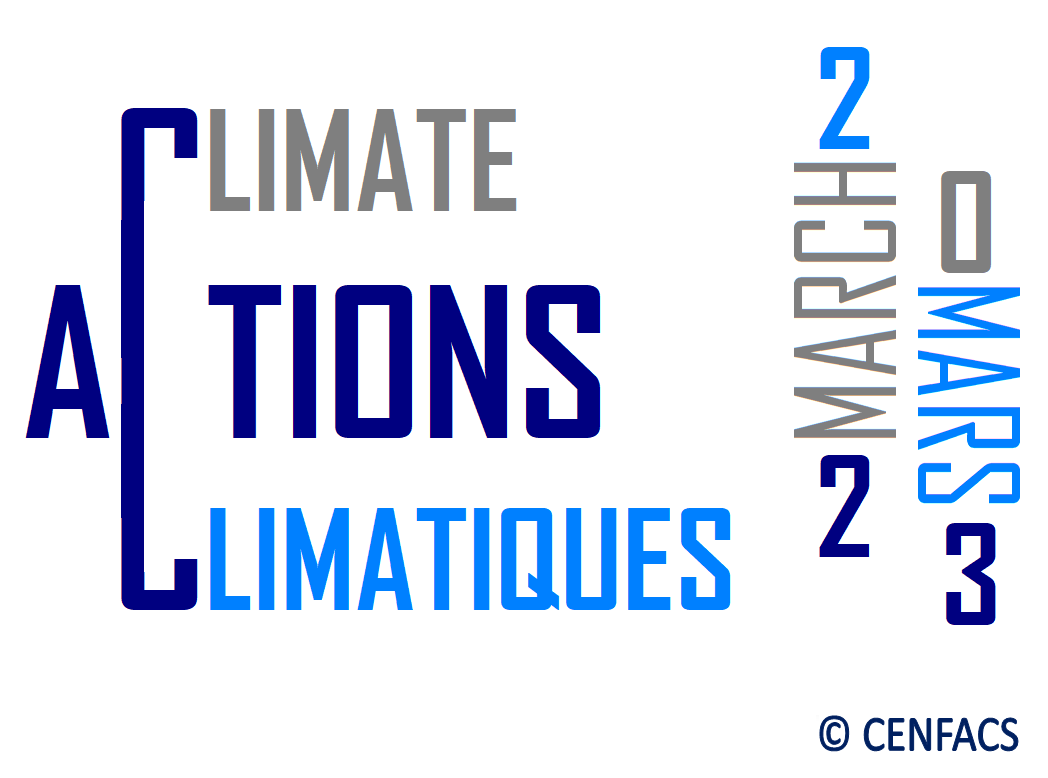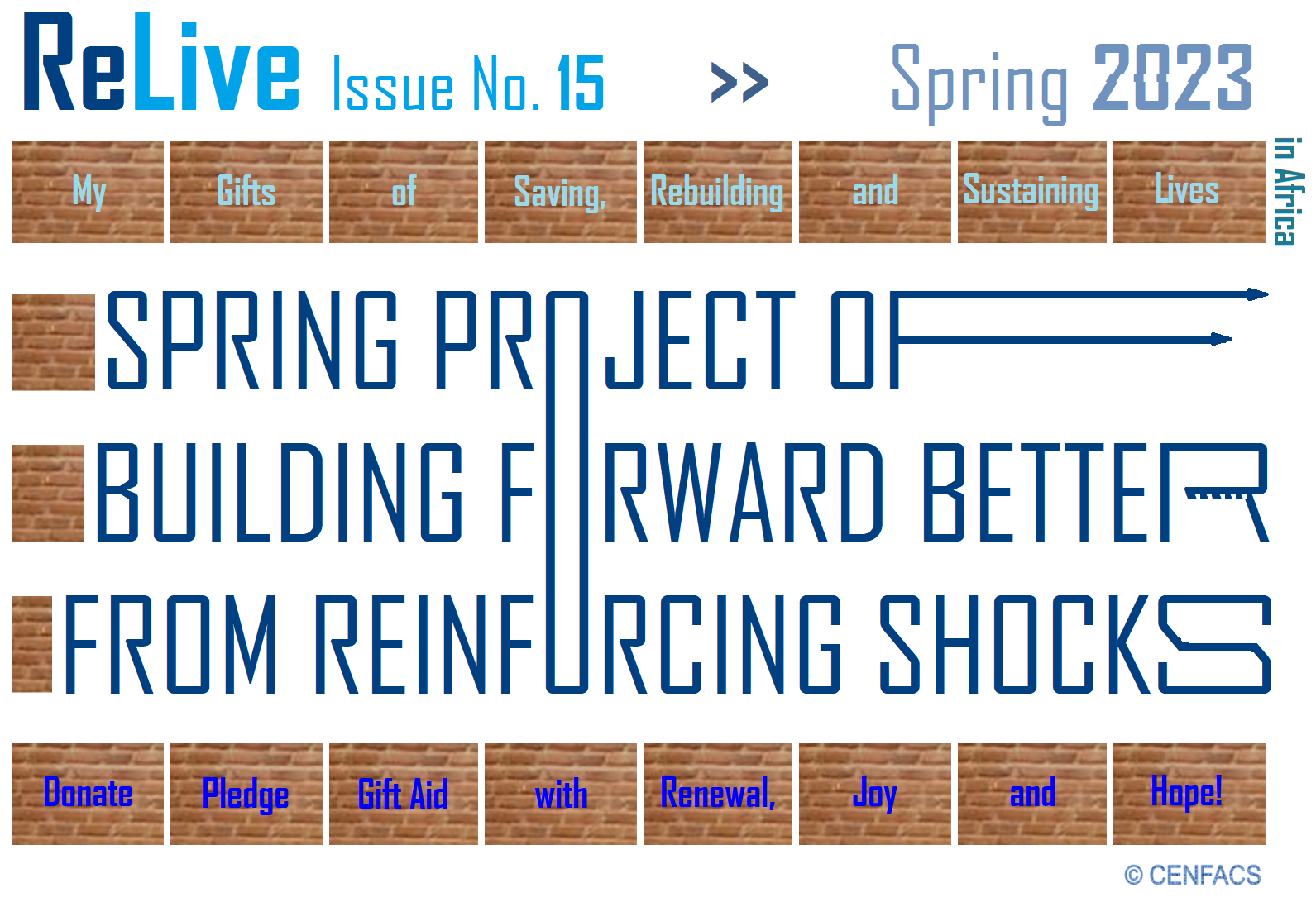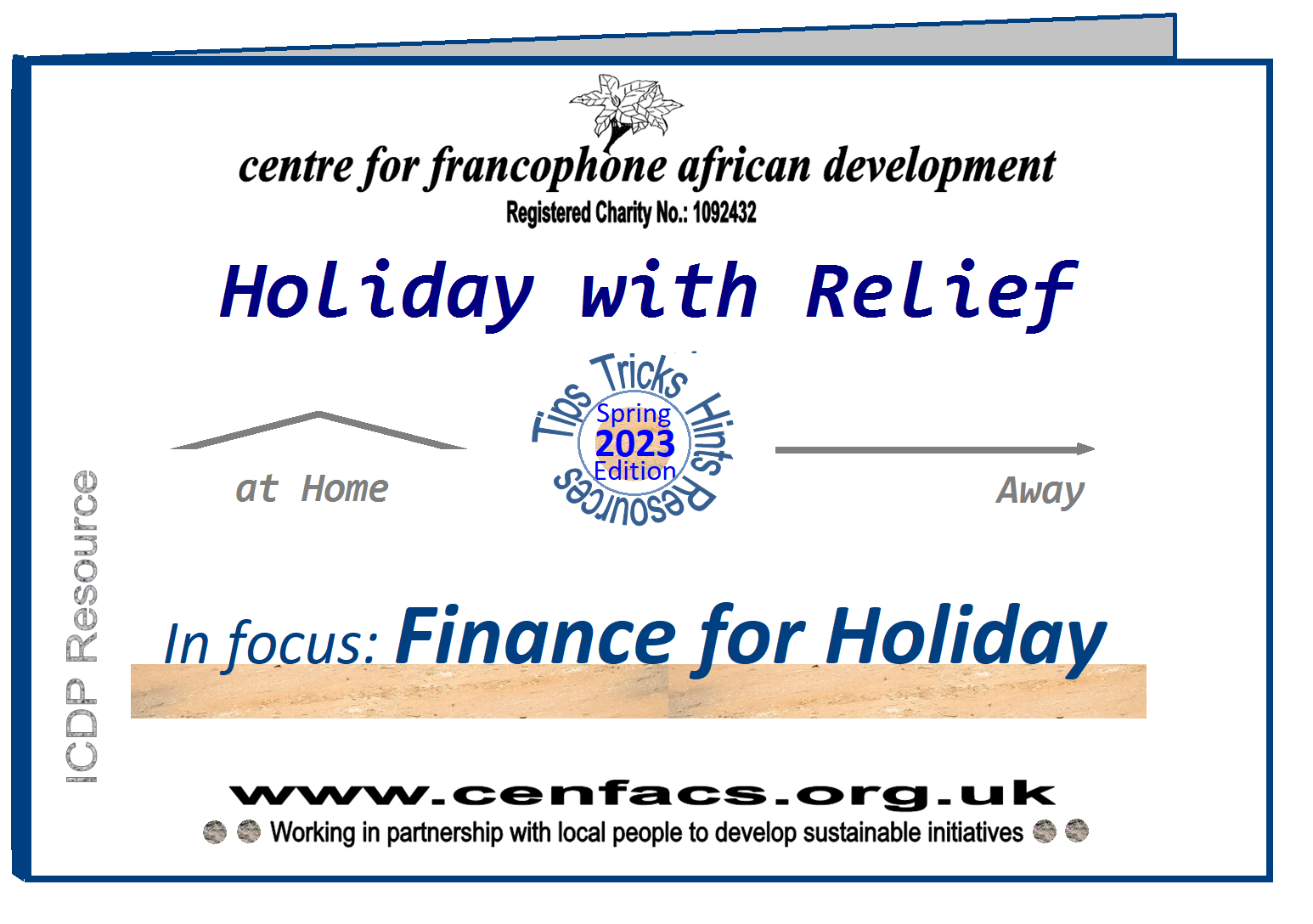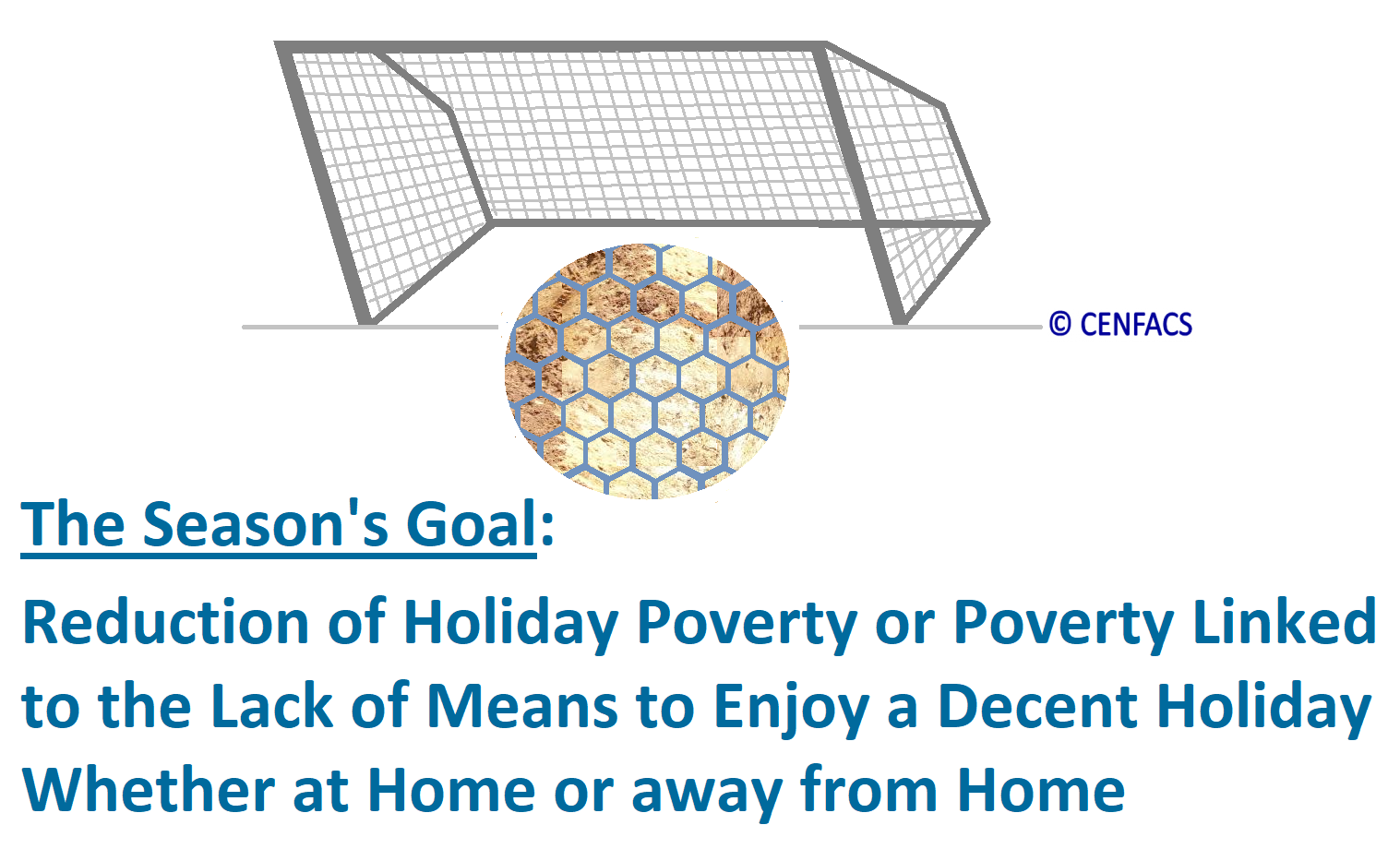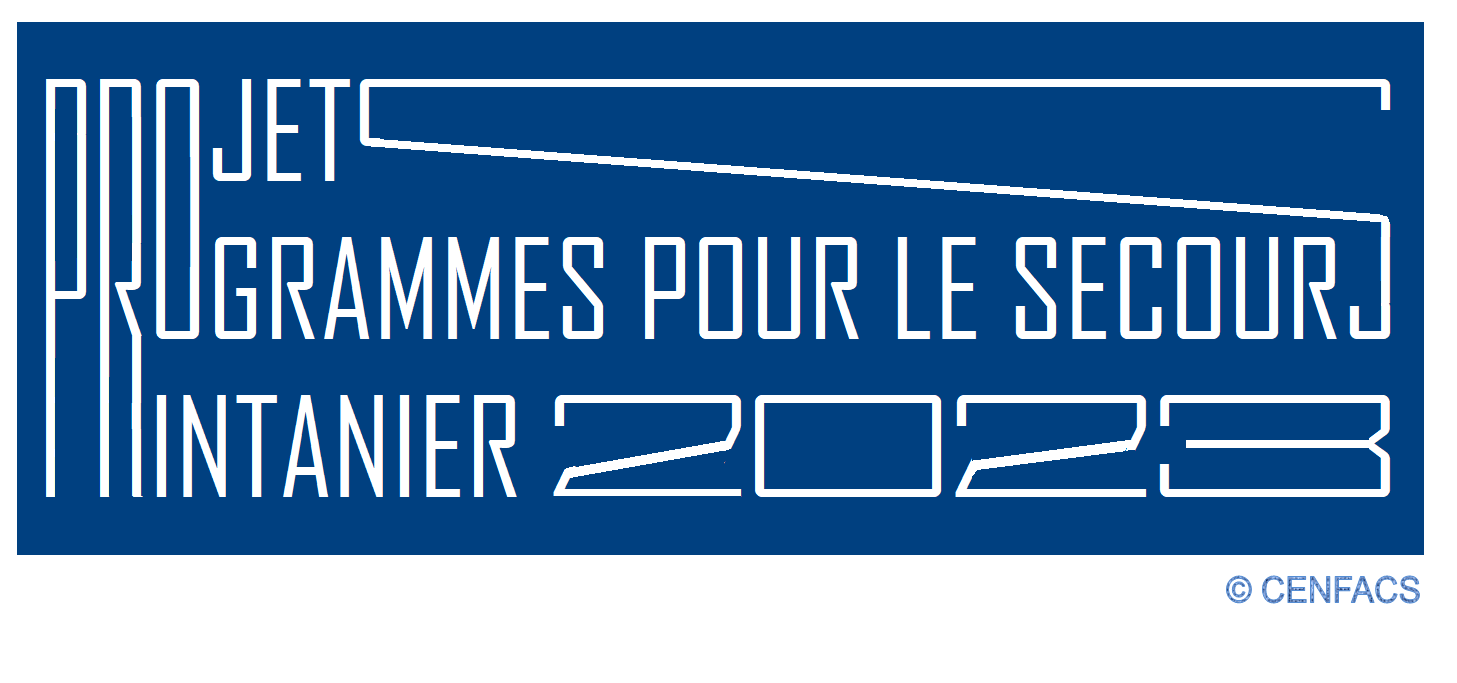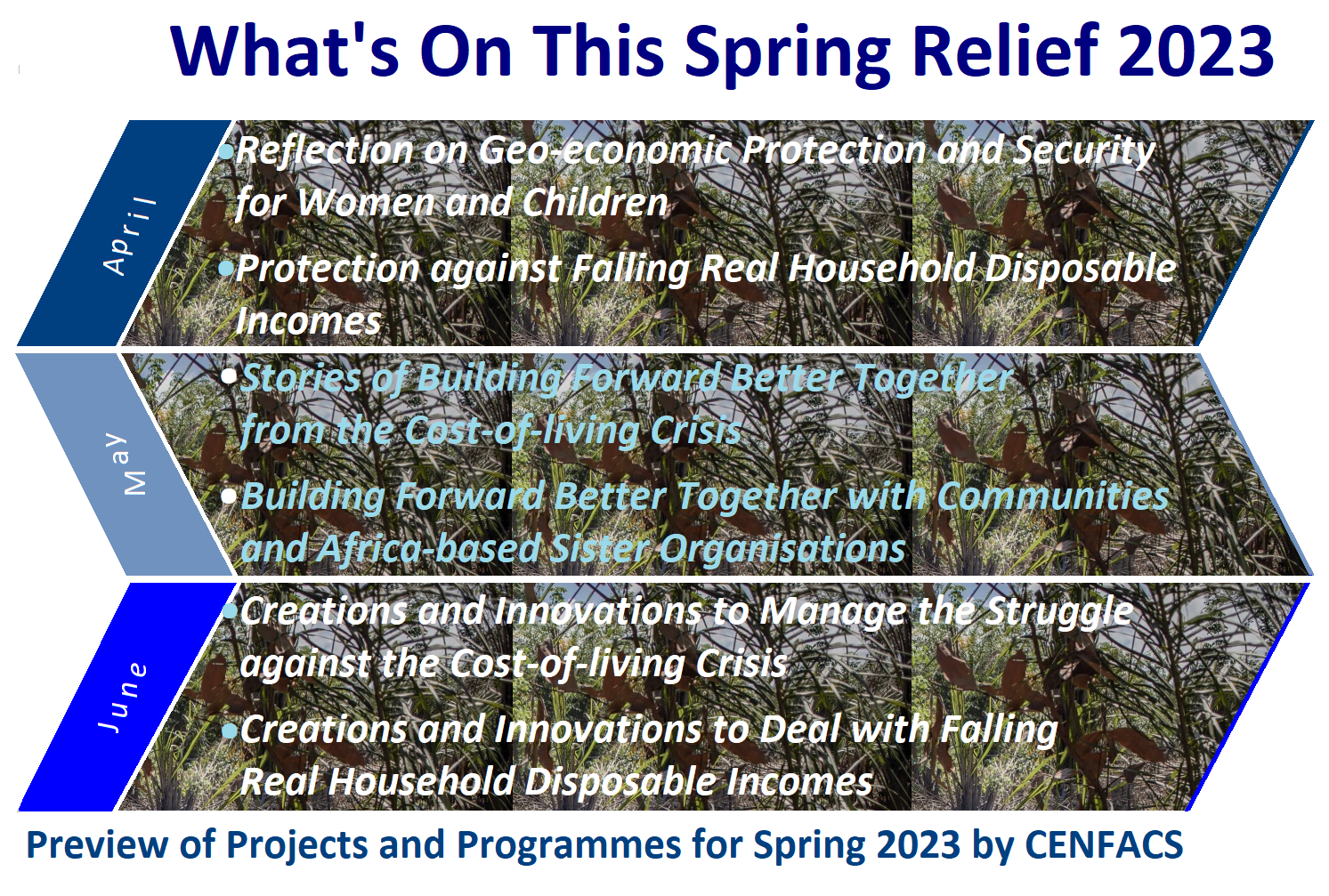Welcome to CENFACS’ Online Diary!
22 March 2023
Post No. 292
The Week’s Contents
• Climate Action 4: Invest in Carbon Credit Markets that Accelerate Climate Action for the Poor
• Coming this Spring 2023: FACS Issue No. 79 which will be titled as Financial Education, Information and Communications for and with the Poor
• ReLive Issue No. 15: Spring Project of Building Forward Better from Reinforcing Shocks in Africa
… And much more!
Key Messages
• Climate Action 4: Invest in Carbon Credit Markets that Accelerate Climate Action for the Poor
The 4th Climate Action is about putting money, time, effort and energy into markets in which verified reductions in carbon dioxide or carbon dioxide equivalents have been registered and recognised; particularly but not exclusively investments that fasten climate action for the poor. In other words, not all carbon credit markets put a particular attention to climate actions taken by the poor. Our focus will be on those markets or credits that consider the poor’s actions on climate change.
Indeed, carbon markets and credits are fundamental to achieving net-zero greenhouse gas emissions. Investing in these markets and credits can help decarbonisation. However, Climate Action 4 is not only about making money from relatively carbon-asset classes or prioritising returns in these markets. It is not just about making your holdings environmentally friendly or greener portfolio. Then, what is it?
It is instead about making sure that the rise of the price of carbon positively impact actions taken by the poor and poverty reduction. It is about investing in carbon projects or markets that meet greenhouse gas emissions reduction by 2050 while ensuring that climate actions taken by the poor are included. In other words, Climate Action 4 is about making return-seeking investors to be also poverty-reduction producers or minders or compliant. This concerns all investors (that is, corporations, institutional and individual investors). In doing so, this can accelerate climate action taken by the poor.
More on this first key message is explained under the Main Development section of this post.
• Coming this Spring 2023: FACS Issue No. 79 which will be titled as Financial Education, Information and Communications for and with the Poor
Financial education is not a new topic in the field of development or as a way of working with part of the population who is not financially educated. Although, it has been around quite a while, it does not reach all the poorest sections of the population, particularly but not exclusively in Africa. Financial information and communications do not reach everybody.
For several reasons or factors, a large proportion of poor people do not receive the amount of financial educational skills, information tools and communication settings they need in order to make jumps or leaps in poverty reduction. They may not always have access to financial information they need which apparently could be available.
In the 79th Issue of FACS, we shall look at the three areas of poor people’s financial empowerment (that is; financial education, information and communication) in the current setting or landscape of development in Africa. We will explore ways of making financial information designed with/for the poor reach them. In other words, we shall look at the handicaps or hurdles that prevent poor people in Africa to get the financial educational skills, information resources and communications tools they need in order to move out of poverty.
The Issue will focus on the basic functional financial educational skills, the financial information market and the travel of this information to the poor in Africa. In this respect, the means of transportation of financial information and how it is consumed by the poor will also be studied and revealed.
Furthermore, the Issue will highlight how Africa-based Sister Organisations are working with their local poor to bridge the gaps in financial education, information and communication. This is without forgetting the problems they are encountering in trying to reduce poverty linked to the lack of financial skills, financial information and financial communications. Of course, this will be done without ignoring the needs of the financial educationally needy, financial uninformed or under informed and communication poor people.
To read more about this new Issue, please keep checking on CENFACS incoming posts this Spring 2023. To reserve a paper copy of this 79th Issue of FACS, please contact CENFACS with your mailing details.
• ReLive Issue No. 15: Spring Project of Building Forward Better from Reinforcing Shocks in Africa (SPBFBRSA)
The 15th Issue of ReLive, CENFACS’ Spring campaign for resource development, is a way of working with the victims of a series of severe and mutually reinforcing shocks (like the lingering effects of the coronavirus disaster, the cost-of-living crisis, debt tightening, natural disasters, etc.) so that they can navigate their way towards the reduction or possibly end of the effects of these shocks on them. It is also about Saving, Rebuilding and Sustaining Lives of the victims from these shocks, disasters and destructions.
SPBFBRSA, which is in fact a fundraising appeal, is about adding value to other similar works and efforts which have been already undertaken so that the poorest people and victims of these shocks can start or continue the process of building forward and reclaiming their lives while Africa is still embattled against these shocks.
In the context of SPBFBRSA, the process of building forward will include the following:
√ Implementing systemic changes
√ Building resilient and sustainable systems of poverty reduction
√ Developing long term capital base in critical assets and resources
√ Shifting away from policy and practice that made and kept these people poor
√ Stopping Africa to be a global leader or champion of poverty
√ Investing in carbon markets to unleash capacities and possibilities to reduce poverty
√ Unlocking home-grown solutions to poverty.
You can find more details about the Spring Project of Building Forward Better from the Reinforcing Shocks in Africa under the page support causes at http://cenfacs.org.uk/supporting-us/
To support and get further information about this project, just contact CENFACS.
Extra Messages
• ICDP (Individual Capacity Development Programme) Resource, Holiday with Relief – In Focus for Spring 2023 Issue: Finance for Holiday
• Nature Projects and Nature-based Solutions to Poverty – Activity for Week Beginning 20/03/2023: A Focus Group on Access and Benefit Sharing of Genetic Resources
• All-year Round Projects Cycle (Triple Value Initiatives Cycle) – Step/Workshop 5: Negotiating and Agreeing your Play, Run and Vote Projects
• ICDP (Individual Capacity Development Programme) Resource, Holiday with Relief – In Focus for Spring 2023 Issue: Finance for Holiday
How to finance your holiday plan without prejudicing other expenses of your household budget
The next Issue of our ICDP Resource entitled as ‘Holiday with Relief’ will focus on funding or financing your holiday.
To pass holiday (like Summer holiday) whether at home or away from home, one needs to find way of financing their holiday. This is because holiday generally costs. Holiday costs can include accommodation, food, travel, insurance, health, etc.
To finance these expenses or costs, it requires to have some savings or take a loan or win a holiday prize if you are lucky or get financial help to cover your holiday costs. Yet, people on low income bracket or with poor income do not have money to save for holiday only and may not be qualified for holiday loan. How are these people going to finance their holiday plan or project?
This year’s Holiday with Relief will look at and bring together the options that could be available to help income poor families or households to fund/finance their holiday plan or budget. In this look, we shall work with these poor families and households by taking a realistic and evidence-based approach to explore ways of funding their holiday without prejudicing other areas of their family/household budget. This is because during and after holiday, there are other expenses to cater for as well.
This year, ‘Holiday with Relief’ will provide wealthy advice, tips and hints linked to financing your holiday. Through this wealth of information, we will try to tackle holiday poverty or poverty linked to the lack of means to enjoy a decent holiday whether at home or away from home.
This resource will be packed with Spring-like poverty-relieving ideas about how to reduce both income poverty while being on holiday. Although the contents of this year’s Holiday with Relief will be for holiday, they can be used at any other time of the year.
To enquire about the 2023 Issue of Holiday with Relief, please contact CENFACS.
• Nature Projects and Nature-based Solutions to Poverty – Activity for Week Beginning 20/03/2023: A Focus Group on Access and Benefit Sharing of Genetic Resources
The current e-discussion or focus group is Activity 5 of our Action Plan for the First Series of Activities about Nature Projects and Nature-based Solutions to Poverty which we kicked off since the 20th of February 2023. This last serial activity will centre stage ways of fairly and equitably sharing the monetary and non-monetary benefits from the utilisation of genetic resources with indigenous peoples and local communities. For an effective participation to the e-discussion or focus group, one needs to understand genetic resources.
• • What is a genetic resource?
The Oxford Dictionary of Environment and Conservation written by Chris Park (1) defines genetic resource as
“Genetic material of plants, animals, or micro-organisms that is of actual or potential value as a resource for humans” (p. 188)
The same dictionary states that
“Genetic is relating to or carried by genes, hereditary or inherited” (p. 187)
Knowing what genetic resource is, it makes easy to participate in the e-discussion or focus group. To participate one needs to be aware of the problem the group is trying to deal with and the solution he/she can bring to the problem and the group.
• • The problem
The main problem found in many models of access and benefit-sharing about genetic resources is often about who own genetic resources, who can access them and who have the right to benefit from them.
• • The solution
The way to solve this problem is to know who has the authority to give access to genetic resources of the species within a particular area and to fairly and equitably share their benefits.
If you are a user of these genetic resources, how would you fairly and equitably share the monetary and non-monetary benefits from the utilisation of genetic resources with indigenous peoples and local communities?
For example, if you are a research student and have access to a genetic site and would like to carry out your research work, how would you share with local people using the same site?
You need to provide your own answers to this question as way of contributing to the e-discussion or focus group. From individual answers given by each participant, the group can formulate the final solution.
• • The next series of nature activities
The above-mentioned e-discussion or focus group concludes our first series of activities featuring the new generation of Nature Projects and Nature-based Solutions to Poverty, which we have covered in 5 weeks. The next series of nature activities will be announced in due course.
For those who would like to engage with Activity 5 about Access and Benefit-sharing of Genetic Resources and/or any of the previous activities (Activity 1 to 4), they should not hesitate to contact CENFACS.
For those who would like to find out more about Nature Projects and Nature-based Solutions to Poverty, they can also contact CENFACS.
• All-year Round Projects Cycle (Triple Value Initiatives Cycle) –
Step/Workshop 5: Negotiating and Agreeing your Play, Run and Vote Projects
Step/Workshop 5 contains two tasks: negotiations and agreement.
• • What is negotiation?
Negotiation is part of humans’ everyday life. To explain it, we are going to refer to what ‘pmi.org’ states about it. The website ‘pmi.org’ (2) provides three features about negotiation, which are
“[a] Communication back and forth for the purpose of making a joint decision
[b] A way of finding a mutually acceptable solution to a shared problem
[c] Achieving an ideal outcome: a wise decision, efficiently and amicably agreed upon”.
Negotiation can be hard, soft and principled. As an all-year-round project user, your negotiation needs to end with negotiated agreement to put your all-year-round project into action, whereby there could be a win-win outcome for you and those engaged with you in the negotiation. Negotiation can lead to an agreement.
• • What is an agreement?
An agreement is simply a joint decision after negotiation or discussion, and can be translated into a contract or promise to carry out what has been negotiated or discussed. The agreement helps to outline the terms and conditions between all-year-round project user and the other party.
• • Example of Negotiated Agreement: Your Project about Playing the CENFACS’ League of Poverty Reduction
Let say you want to run a tournament over this coming Easter season with friends or relatives in order to find which African country is making commendable progress in terms of poverty reduction. You need to negotiate with friends and/or relatives the terms and conditions of this tournament. Your negotiation could revolve around the following:
~ the number of African countries making your Easter tournament
~ the criteria or metrics to rate them in terms of performance relating to poverty reduction
~ the analytical period you would like to consider (e.g., 01/01/2023 to 31/03/2023 or first quarter of 2023)
~ the roles each of the participants to the game would like to play
~ the length of the tournament
~ the time and day of the Easter holiday to play
~ the way of recording and communicating your results
etc.
After negotiation, you need to agree on certain terms, conditions and rules to follow during the play.
Depending on your skills, knowledge, experience and resources; you may decide to turn your game into a play station or use a game theory to solve some of the hurdles you may encounter.
For those who would like to dive deeper into the negotiation and agreement relating to their Play or Run or Vote project, they should not hesitate to contact CENFACS.
Message in French (Message en français)
Projets et Programmes pour le Secours Printanier 2023
Le CENFACS a le plaisir de présenter sa collection de projets et programmes sélectionnés pour la nouvelle saison (printemps) avec un choix de services de secours et intelligents face au climat.
Pour chacun de ces projets et programmes, vous trouverez une ambition de développement résiliente au climat ainsi qu’un soulagement convivial et centré. Ils sont conçus avec les parfums d’inclusion, de sécurité et de durabilité.
Ce sont les projets et les programmes visant à reconstruire des vies, des infrastructures et des institutions pour que nous avançons mieux ensemble plus verts, plus propres et plus sûrs vers un monde à zéro émission nette.
Ils sont gratuits, mais si quelqu’un(e) décide de faire un don, leur don ne nous dérange pas. Plus vous donnez, plus nous pouvons aider à réduire la pauvreté.
Veuillez trouver ci-dessous la sélection des projets et programmes pour le Secours Printanier 2023.
Avril : Mois de la protection
Il y aura deux initiatives pour assurer et maintenir la protection en avril 2023 :
a) Protection et sécurité géoéconomiques des femmes et des enfants
b) Protection contre la baisse du revenu disponible réel des ménages.
Mai : Mois du conte d’histoires
Le plan pour mai 2023 comporte deux caractéristiques principales:
a) Projet de narration et de partage d’histoires
b) La poursuite de notre projet/campagne ‘Reconstruire l’Afrique’.
Juin : Mois de la création et de l’innovation
En juin, nous traiterons des initiatives suivantes:
a) Créations et innovations de lutte contre la crise ou celles qui aident à la lutte contre la crise du coût de la vie
b) Créations et innovations de gestion de crise, c’est-à-dire celles qui aident à gérer la période de lutte contre la crise du coût de la vie.
Ce qui précède résume les programmes, projets et activités que nous avons prévu de mettre en œuvre au printemps prochain. Pour obtenir de plus amples informations sur les projets et programmes de Secours Printanier 2023, veuillez contacter le CENFACS.
Main Development
• Climate Action 4: Invest in Carbon Credit Markets that Accelerate Climate Action for the Poor
The following notes will help in taking Climate Action 4:
σ What is investing in carbon credit markets?
σ What is accelerating climate action for the poor?
σ Types of carbon investors required
σ Accelerating climate action with and for the community and Africa-based Sister Organisations
σ Carbon-related assets and green funding for climate action.
Let us look at each of these notes.
• • What is investing in carbon credit markets?
It is about putting money, effort, time and energy in a market in which carbon emission allowances are traded. This market is carbon credit if there is the removal of one tonne of carbon dioxide equivalent (i.e., tCO2e) from the atmosphere. In these markets, carbon is an investment asset class. And investing in carbon markets can help decarbonise. This is whether it is about first or second market trading in carbon offsets. Investing in carbon markets should not be only a tool to accelerate low carbon development; it has to fasten climate actions for the poor as well.
• • What is accelerating climate action for the poor?
Climate action is an activity of engaging and putting ideas into practice to deal with any natural or induced change in the long term average weather conditions of a place, especially when this change adversely affects people’s and communities’ lives and livelihoods. This action can be fastened for the poor. There are many ways of fastening it. One way of fastening it is to ensure that investing in carbon markets and credits does not limit itself to financial return only; it should instead go beyond by including the needs of the poor in any investment drive.
For example, investing in the world’s three largest carbon sinks or tropical rainforests (like the Amazonia in Brazil, the Congo basin in the Democratic Republic of Congo and the forests of Indonesia) to preserve their vast forests threatened by exploitation and agriculture can help to accelerate climate action for the poor.
To be more specific, Southeast Asia has 15 per cent of the world’s tropical forests and contain the world’s highest concentration of blue carbon stocks. They also hold the highest potential for added key biodiversity co-benefits. Investing in Southeast Asian forests can help decarbonise.
Equally, investing in the newly set up Africa Climate Risk Facility and African Carbon Markets Initiative (3) can also help fasten climate action for the poor. For instance, carbon investors can invest in Egypt’s carbon credit market.
The above-mentioned examples are just the few ways of accelerating climate action for the poor.
• • Types of carbon investors required
Carbon market investors can be of variant types or calibre. They can be corporations, institutional and individual investors. There are investors (particularly financial ones) who provide valued-added services such as liquidity, helping in price discovery, matching supply and demand, making market to happen, etc.
There are investors who are interested in these markets because of carbon offsets. There are others who are return seekers and would prioritise returns. There are other more aiming at the environmental friendliness of their portfolios.
In the context of these notes, the kind of investors we are interested in are those who keep the net-zero objective in their portfolio while helping to accelerate climate action for the poor. Those who are making their holdings greener or environmentally friendly while contributing to fastening climate action for the poor.
• • Accelerating climate action with the community and Africa-based Sister Organisations (ASOs)
Accelerating climate action with the community and ASOs is about bridging the gaps between climate actions and ambitions in both cases.
• • • Accelerating climate action with and for the community
Accelerating climate action with and for the community is about staying climate-conscious at all times. This action includes
√ Raising awareness of the the attractiveness of carbon
√ Helping the community to learn about the prices of carbon-related assets
√ Explaining and re-explaining net-zero policy commitments and the co-benefits attached to them
√ Discussing nature-based offsets (e.g., those generated from tree-planting schemes)
√ Information about insurance products to protect against carbon offset invalidation
√ Advising about the current market value for key carbon markets and products
√ Finding with and for the community the compensation available from the international community to reduce deforestation
Etc.
• • • Accelerating climate action with and for Africa-based Sister Organisations (ASOs)
Accelerating climate action with and for ASOs is about exchanging knowledge, tools and skills about investments in carbon markets. Areas of exchange could be the following:
√ Supporting ASOs to know and learn more about the types of carbon-related investments like carbon mutual funds, green bonds and organisations, carbon credit futures, etc.
√ Analysing trends about where carbon-related investments are going (for example, investments in funds that are considered to be low-carbon, fossil free funds, etc.)
√ Advising and finding information for them on investments made in carbon-credit-related organisations, organisations with operations at low impact on the environment, organisations making voluntary greenhouse gas emissions reductions or net-zero pledges
√ Finding ways of increase for the value of Africa’s tropical forests to climate and people
√ Working on the development of fossil energies to provide solutions to climate change
√ Analysing the effects of the growth of the carbon credits market on poverty reduction.
For example the website ‘marketwatch.com’ (4) states that
“The carbon credit market is anticipated to rise at a considerable rate during the forecast period between 2023 and 2029… Carbon credit market size is projected to reach multimillion UD$ by 2029”.
We can analyse or discuss how this rise or size of the carbon credit market is going to impact poverty reduction in Africa in the future.
The above are just the few ways of accelerating or enhancing climate action with and for ASOs.
• • Carbon-related assets and green funding for climate action
Just as investors can use cryptocurrencies and non-fungible tokens to fund projects, carbon investors can use carbon-related assets or offsets to fund climate action projects. They can fund CENFACS‘ climate action initiatives or our ASOs. They can as well finance climate poverty reduction projects.
To round out, climate action is about action, not words only. We have only written these notes to guide us and galvanise our action. This is because to take action, one needs a roadmap or simply to say how they are going to conduct this action.
The notes on Climate Action 4 conclude this Week’s Climate Action contents without ending our March 2023 Climate Actions. There will be impact monitoring and evaluation from 29 to 31/03/2023 to end the Climate Action March 2023.
For ASOs and those members of our community who are interested in the fourth action of our Climate Action Month, action which is Invest in Carbon Credit Markets that Accelerate Climate Action for the Poor; they are welcome to contact CENFACS.
For any other queries and enquiries about CENFACS‘ Climate Action Month, the theme of ‘Making Carbon Markets Work for the Poor’ and the fourth action; please do not hesitate to contact CENFACS.
_________
• References
(1) Park, C. (2011), Oxford Dictionary of Environment and Conservation, Oxford University Press, Oxford and New York
(2) https://www.pmi.org/learning/library/negotiating-project-outcomes-develop-skills-6781 (Accessed in March 2023)
(3) https://fsdafrica.org/press-release/leveraging-the-african-insurance-industry-to-create-resilient-african-economies/# (Accessed in February 2023)
(4) https://www.marketwatch.com/press-release/carbon-credits-market-statistics-2023-industry-demand-prominent-players-strategies-size-swot-analysis-and-forecast-2029-2023-01-11 (Accessed in March 2023)
_________
• Help CENFACS keep the Poverty Relief work going this year
We do our work on a very small budget and on a voluntary basis. Making a donation will show us you value our work and support CENFACS’ work, which is currently offered as a free service.
One could also consider a recurring donation to CENFACS in the future.
Additionally, we would like to inform you that planned gifting is always an option for giving at CENFACS. Likewise, CENFACS accepts matching gifts from companies running a gift-matching programme.
Donate to support CENFACS!
FOR ONLY £1, YOU CAN SUPPORT CENFACS AND CENFACS’ NOBLE CAUSES OF POVERTY REDUCTION.
JUST GO TO: Support Causes – (cenfacs.org.uk)
Thank you for visiting CENFACS website and reading this post.
Thank you as well to those who made or make comments about our weekly posts.
We look forward to receiving your regular visits and continuing support throughout 2023 and beyond.
With many thanks.

